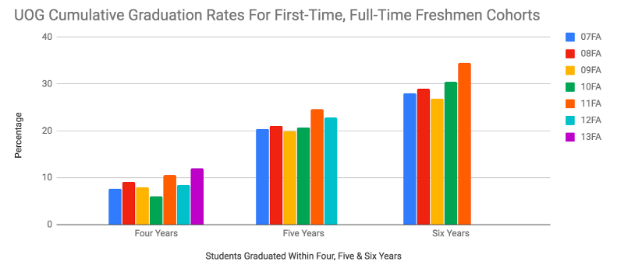Nationwide, the problem of college students not graduating in four years is extremely prevalent. These days, graduating in five or even six years is the new normal, which is understandable when you consider all the factors of student life.
The Factors of Low On-Time Completion
Students already know this. Often times college courses are not offered regularly, so students miss an important prerequisite and get a semester behind. Or a student could be placed in developmental courses, which could extend their time in college.
Even if that weren’t the case, having a full-time load all four years doesn’t necessarily mean you’ll graduate on-time. Full-time for a semester is only 12 credits. After eight semesters, that’s only 96, and UOG students need 124 credit hours to graduate.
If a student took 15 credit hours a semester, that still only puts them at 120 after four years. It’s possible to graduate on-time if you take intercession classes, but that’s not always financially feasible.
Plus, most students these days are working while going to school, which makes being a part-time student the only option. Or maybe they have to take a semester off because they have a hold at the Bursar’s office. Student loans are no joke.
In fact, according to Forbes, “There are more than 44 million borrowers who collectively owe $1.5 trillion in student loan debt in the U.S. alone. Student loan debt is now the second highest consumer debt category – behind only mortgage debt – and higher than both credit cards and auto loans.”
Just last year at UOG, the total amount of financial aid given to students was $23,015,378 according to the UOG Factbook.
On-Time Completion at UOG
According to Deborah Leon Guerrero, Assistant Vice President of Institutional Effectiveness, the different colleges at UOG cater their programs for a four-year completion time.
“When the curriculum is designed, and when the courses are offered, the expectation of the faculty is [to develop] a four year program,” Leon Guerrero said.
But students still aren’t graduating in four years, because the programs are designed to succeed given that the student is not placed in developmental courses and they declare their major during their freshman year.
Scott Ishizu, UOG sophomore, plans to graduate in six years. Ishizu came to UOG in Fall 2016 and declared as a business major last semester.
When I asked him if he thinks UOG helps students graduate in a timely manner, Ishizu replied: “They try, but with the change [in the Business program], it really messed things up.”
According to Ishizu, factors like changes in academic programs and times when classes are available prevent him from graduating sooner than six years.
Because of all the factors aforementioned, and because UOG is an open-enrollment institution, five or six years is a more realistic number for student completion.
“Because of open admissions, there’s going to be a portion of that time where [students are] in developmental courses,” Leon Guerrero said. “But that’s okay, because we are…here to serve the community, right. And so we don’t want to discourage anyone. Just because you’re not college ready doesn’t mean, you’re not able to go to college.”
Lawrence Camacho, dean of Enrollment Management and Student Success, welcomes open enrollment.
“It’s a wonderful thing,” Camacho said. “A lot of those are those first generation students and we’re attracting because it’s an open enrollment. It’s affordable. It’s convenient, it’s here and we want them to come.”
It’s not a bad thing that students take a little longer to graduate, but compared to national averages, the six-year graduation rates for UOG are alarmingly low. UOG is not completing as many students as it should be.
UOG compared with other Universities
According to the National Student Clearinghouse Research Center, the total completion in six years at the same institution for four-year public universities is 54.54%.
UOG’s six-year completion rate for the 2011 cohort (the highest it’s been in recent years) is only 35.4%. That means only 35.4% of students in that cohort graduated within six years.
According to Leon Guerrero, UOG compares itself to three different types of universities: open admission peer institutions, an aspirant list (universities that are doing well that UOG aspires to), and off-island schools that a lot of local high school seniors decide to go to.
Leon Guerrero agreed that UOG’s six-year completion rates are low to national standards, but said they are closer to other open enrollment institutions.
“Those open enrollment are not really at the 50 [percent], they might be at the 40 percent,” Leon Guerrero said.
Graduation rates for previous years at UOG, taken from the UOG Factbook, can be seen below:
“We are still lower than we want to be,” Leon Guerrero said. “We want to increase [our rates] and in fact, our accreditors said to focus on that as well. That’s one of the recommendations that they had is ‘focus on completion.’”
It’s important to note that transfer students are not considered in this data, and there’s a large percentage of students that transfer out. Below are the transfer and stop-out rates from the UOG Factbook after for students at UOG after six-years.
It’s good to see that in recent years, the transfer and stop-out rate is slightly decreasing. But the numbers are still high – higher than the six-year completion rates.
The Institutional Effectiveness Office disseminates surveys for students that stop-out to take, to figure out why they aren’t coming back.
“We found that there’s a handful of reasons,” Leon Guerrero said. “One is they have said is for financial reasons, that the courses that they wanted to take are not available, or that they had personal obligations that they needed to fulfill.”
According to the survey, when undergraduates were asked what led to their decision for not returning to UOG, the top reason was financial aid issues.
“So no doubt that this is recognized as an area that is a priority,” Leon Guerrero said. “And that’s why we’ve got all of these initiatives going on.”
Possible Solutions
At EMSS, Camacho is working to implement initiatives and strategies that help students complete on-time.
“We want to make sure students are graduating, because why? Because they’re paying more, you know, and we don’t want them to pay more,” Camacho said.
High impact practices are strategies that have been studied and proven to increase student success. According to Leon Guerrero, intrusive advising is a big indicator of student success because it helps students feel a stronger connection with the university.
When looking at the top performing colleges at UOG, intrusive advising is a key component in all of them, which is a big reason why the ID180 course was replaced with the FY101 course.
Another recent initiative is the Bounce Back program, which aims to engage with students placed on academic probation.
Ishizu was placed on academic probation before the Bounce Back program was started. He said that all he had to do was go in to the Student Center, sign some papers, and tell the office how he was going to better his GPA. There was no follow up afterward.
Now, according to Camacho, students placed on academic probation are sent regular emails and given workshops and tutoring services to engage with students better. This initiative aims to get students out of academic probation faster.
Leon Guerrero and Camacho believe that increasing student services like these will help the on-time completion problem.
But, one problem area Leon Guerrero cited is the amount of money allocated to student services. Compared to the open admission peer institutions and aspirant colleges, the money that UOG spends on student services is “fairly low.”
“That means the resources that the university is able to put towards more of the the high impact practices is not as high as our…our peer institutions,” Leon Guerrero said. “So that’s one of the things that the university is looking at is ‘how can we increase the resources that we put to student services?’”
So, like everything, it all comes down to money. There’s a huge budget crisis in education on Guam right now, but Leon Guerrero believes it’s possible to find the resources UOG students need.
“That’s life. You do the best with the resources that you have,” Leon Guerrero said. “But if other institutions that are relatively in our same profile are able to to do that, you know, we’re going to look to our legislature or to the endowment foundation…something to help boost the resources that they have in there.”
There have been many recent initiatives started by the EMSS office, but we won’t know their true effect until time passes. As the university compiles more data over the years, we can look to see if the graduation rates are increasing.
“Institutions are data driven,” Camacho said. “They look at the numbers to be able to see that right, because then we have nothing. There’s no other force that’s out there to tell us that.”
Like many other problems, the low on-time completion rates are going to take money and time to fix. It’s the institution’s responsibility to engage and help the students more.
But Ishizu says that it’s also on the students to be involved with the programs.
“They can offer so [many programs] but as students if we don’t take advantage of it, then I see no point,” Ishizu said.
So make sure to be on the lookout for events, programs or opportunities that UOG advertises. Services like the writing center, the math tutor lab, and financial aid workshops are available to help you.
This spring semester, there are currently 383 graduation applicants, which according to Camacho, is the largest graduating class for UOG yet.
I wonder how many of those students are graduating within six years, and I hope that number continues to grow.

